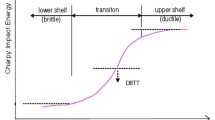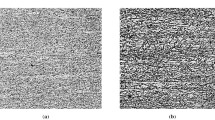Conclusions
-
1.
The temperature relationship of impact strength of N26T3 steel correlates with the relationship of the length of zone L located close to the source of fracture and having a wrinkled microrelief with elongated pits.
-
2.
In impact fracture of hardened N26T3 steel the quantity of α-martensite within the limits of the zones of plastic deformation remains constant despite the existing gradient of deformation of the material in these zones.
-
3.
The thickness of the strongly deformed microzone of plastic deformation depends upon the microrelief in the center portion of the fracture and the thickness of the weakly deformed macrozone upon the stressed state of the material at fracture.
Similar content being viewed by others

Literature cited
A. P. Gulyaev and A. M. Minaev, "A study of the impact strength of austenitic steels at low temperatures," Metalloved. Term. Obrab. Met., No. 10, 45–49 (1966).
O. A. Bannykh and Yu. K. Kovneristyi, Steels for Operation at Low Temperatures [in Russian], Metallurgiya, Moscow (1969).
A. I. Uvarov, "The influence of austenite stability on the mechanical properties of nonmagnetic aging steels and alloys," in: High-Strength Nonmagnetic Steels [in Russian], Nauka, Moscow (1978), pp. 192–200.
K. A. Malyshev and N. D. Zemtsova, "The kinetics of the martensite transformation and morphology of martensite in N25KhT3 alloy after aging," Metalloved. Term. Obrab. Met., No. 9, 38–43 (1972).
G. V. Klevtsov and B. B. Shvets, "X-ray diffraction analysis as a method of investigation of fractures," in: Equipment and Methods of X-Ray Diffraction Analysis [in Russian], No. 35, Mashinostroenie, Moscow-Leningrad (1986), pp. 3–11.
L. R. Botvina, G. V. Klevtsov, and Yu. S. Gladilov, "The zones of plastic deformation under the fracture surface of 45 steel," Probl. Prochn., No. 10, 55–59 (1982).
L. I. Lysak and B. I. Nikolin, Physical Fundamentals of the Heat Treatment of Steel [in Russian], Tekhnika, Kiev (1975).
L. R. Botvina, E. I. Kolokolov, E. B. Karnin, and P. A. Zakharova, "Critical crack length in shock loading," Zavod. Lab.,41, No. 11, 1390–1394 (1975).
G. V. Klevtsov and L. R. Botvina, "The micro- and macrozones of plastic deformation as a criterion of the limiting condition of a material at fracture," Probl. Prochn., No. 4, 24–28 (1984).
P. M. Kozlov, "The method of structural tinting of fractures," in: Collection of Works of the Department of General Physics [in Russian], Kirgiz State Univ., Frunze (1964), pp. 8–11.
Additional information
Frunze Polytechnic Institute. Translated from Metallovedenie i Termicheskaya Obrabotka Metallov, No. 2, pp. 13–17, February, 1991.
Rights and permissions
About this article
Cite this article
Klevtsov, G.V., Gorbatenko, N.A. & Uvarov, A.I. Martensite transformations in zones of plastic deformation in impact loading of N26T3 steel. Met Sci Heat Treat 33, 106–110 (1991). https://doi.org/10.1007/BF00773883
Issue Date:
DOI: https://doi.org/10.1007/BF00773883



